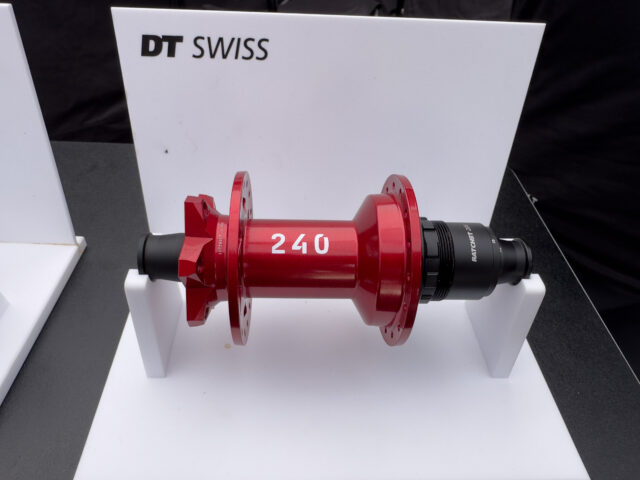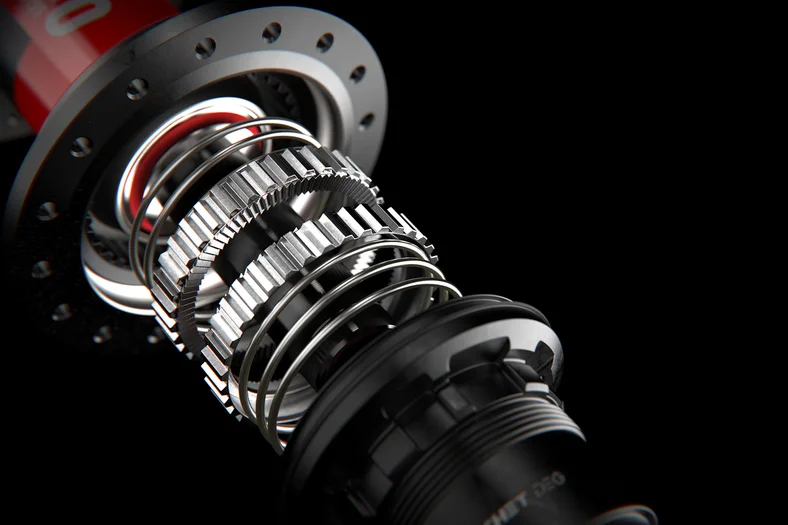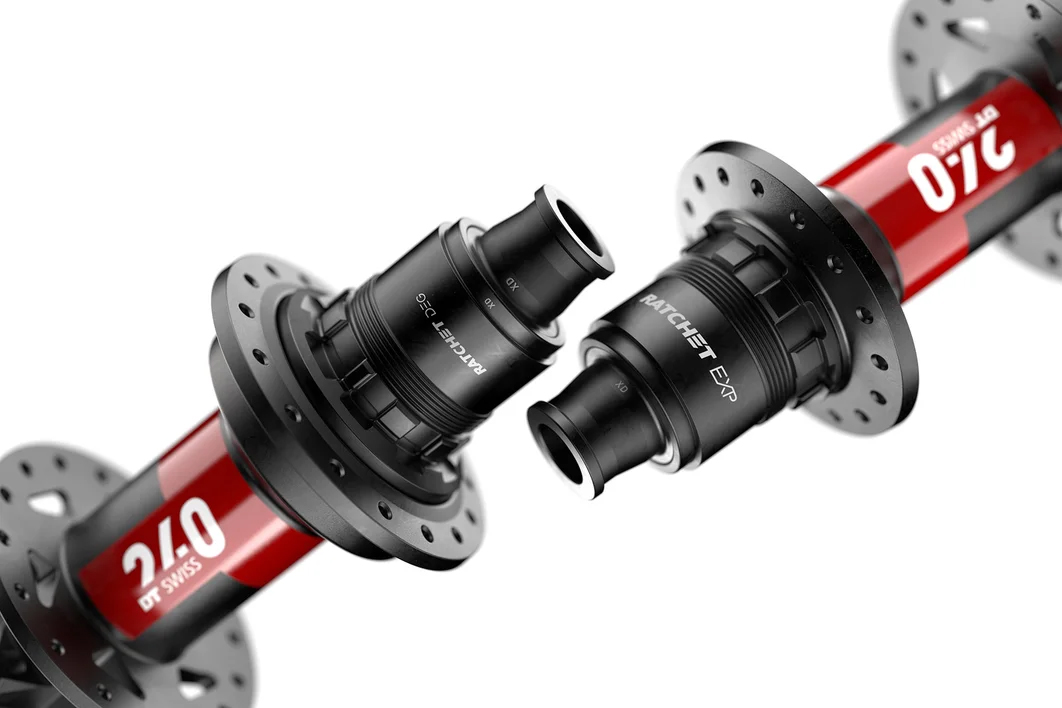DT Swiss 240 Ratchet DEG Hub
Axle Option: 12 x 148 mm Boost rear
Hole Count: 28 or 32
Rotor Mount: Six Bolt
Points of Engagement: 90
Freehub Options: Shimano Microspline and SRAM XD
Stated Weight: 270 g (rear hub only)
MSRP: $500 (rear hub only)

Intro
DT Swiss has been making Star Ratchet hubs for a very long time now, and while their 240 hubs have long been a popular option for a very durable hub at a relatively low weight, some folks have found their relatively low number of engagement points to be limiting.
That’s where DT’s new 240 Ratchet DEG hub comes in, with 90 points of engagement, and a promise of easier serviceability while they’re at it. Let’s see what DT has come up with.
Hub Design
Let’s start with what hasn’t changed. The 240 Ratchet DEG rear hub is new, but it’s paired with the same 240 front hub that’s been around for a while now. And the 240 Ratchet EXP rear hub sticks around too — the Ratchet DEG is an addition to the lineup, not a replacement for any existing models.
The overall layout and design of the new Ratchet DEG rear hub haven’t changed a ton from 240 hubs of old, either. The 240 Ratchet DEG still uses a version of DT’s longstanding Star Ratchet drive system — just one that’s been made a lot bigger to accommodate the additional points of engagement. In short, rather than using pawls, the Star Ratchet uses a pair of toothed rings that mesh with each other around their full circumference. Depending on the generation of Star Ratchet hub design (more on that in a minute), one or both of the rings slide in and out on a splined interface (hence “Star Ratchet”) with a spring or two forcing them together.

The original Star Ratchet hubs came with a now-quaint-sounding 18 points of engagement, but DT added 36 and later 54-tooth versions of the ratchet rings down the line, both of which were drop-in upgrades for existing hubs. That version used two moving ratchet rings, with both the one in the hub shell and the one in the freehub body able to move in and out to meet the other, with a spring behind each pushing them together. A threaded drive ring in the hub shell acts as the housing for the inner ratchet ring; the freehub body has the splines for the outer one machined into it directly. A spring behind each ratchet ring pushes the two together.
Then a few years ago, DT introduced the Ratchet EXP ratchet mechanism, which moved to a fixed ratchet ring in the hub shell, with only the one in the freehub body moving. It works in pretty much the same way as the original Star Ratchet design, but by combining the threaded drive ring and the inner ratchet ring into one non-moving piece and dropping the inner spring, the Ratchet EXP system shaved a few grams over the longstanding original Ratchet mechanism. DT also makes a bigger, beefed-up version of the Ratchet EXP, Ratchet EXP OS, which is effectively just a scaled-up version of the same design, meant to handle the increased torque of eBikes. The original Ratchet system is still around in DT’s mid-range 350 hubs, but it’s been replaced by the Ratchet EXP design in the higher-end 240 and 180 lineups. The standard Ratchet EXP is offered with 36 or 54 teeth (and thus 36 or 54 points of engagement); the Ratchet EXP OS drops down to 30 so that the teeth can be bigger and more robust.
And that gets at the thinking behind the Ratchet DEG hub. The Ratchet EXP system, with up to 54 points of engagement, lags behind a lot of higher-end hubs when it comes to engagement speed. I’m still of the opinion that going really buck wild with the points of engagement becomes a case of rapidly diminishing returns, but 36 POE is about the floor for what I’m more or less okay with, and a bit more than that is definitely nice at times. But cramming more teeth onto the Ratchet EXP (or standard Ratchet) rings means making the teeth smaller, and DT could only go so far before the teeth got too small, with too shallow an engagement, and wouldn’t hold up.
So the solution was to make the ratchet rings a lot bigger — which is exactly what they’ve done with the Ratchet DEG. The design is very, very similar to that of the original Ratchet system — interestingly, the Ratchet DEG hubs go back to two moving rings and two springs to drive them, unlike the Ratchet EXP arrangement — and by doing so DT has been able to fit 90 teeth onto the bigger Ratchet DEG rings. The bigger rings also necessitate a bigger hub shell and freehub body, so the Ratchet DEG system, unsurprisingly, can’t be retrofitted to an existing hub. The added material, also unsurprisingly, adds a bit of weight — about 40 grams compared to a 240 Ratchet EXP hub.

Another benefit to the Ratchet DEG system over the Ratchet or Ratchet EXP designs, is that the larger ratchet rings mean that access to the drive side hub shell bearing isn’t obstructed by the threaded drive ring (Ratchet) or ratchet ring (Ratchet EXP). On those hub designs, it’s necessary to remove the threaded ring from the hub shell to access and replace the drive side hub shell bearing. While it’s not hard in theory, doing so (1) requires a proprietary tool (and the Ratchet and Ratchet EXP ones are different) and (2) since pedaling torque tightens the drive ring into the hub shell, they can get very stuck and hard to remove. The Ratchet DEG drive ring has a big enough inner diameter to do away with all that — the bearing clears it with plenty of room to spare.
Wheel Options
The 240 Ratchet DEG rear hub is currently available as a standalone hub with 148 x 12 mm Boost spacing and a six-bolt rotor mount with 28- or 32-hole drilling for standard J-bend spokes, or in the XMC 1501 and EXC 1501 system wheels. Both complete wheel options use 28 straight pull spokes and six-bolt rotors. DT Swiss offers Microspline and XD drivers for the Ratchet DEG hub, but folks still using HG cassettes are out of luck, as are riders with Super Boost spaced frames.
The Ratchet DEG rear hub retails for $499 USD on its own; both of the complete wheel options are available for $900 (front) and $1,100 (rear). Both get carbon rims, but the XMC is designed for all-around Trail bike use while the EXC version is intended for heavier-duty Enduro bikes.

Some Questions / Things We’re Curious About
(1) How do the Ratchet DEG hubs hold up? DT has a great track record on that front overall, but stumbled with some of the early Ratchet EXP hubs. They seem to have gotten that issue under control but did they get the Ratchet DEG right from the get-go?
(2) How noticeable is the increased engagement speed of the Ratchet DEG rear hub compared to the Ratchet EXP version? What about when comparing the Ratchet DEG to hubs with really high engagement, such as Industry Nine Hydras?
(3) And what about noise? DT’s hubs have historically been relatively quiet (pleasantly so, in my book) — but does that continue with the Ratchet DEG?
Bottom Line (For Now)
I’ve long been a fan of DT’s hubs, and the new 240 Ratchet DEG looks like a promising addition to their lineup, with faster engagement than they’ve offered before, and easier serviceability now that there’s no need to remove the drive ring to access the drive side hub shell bearing. We’ve got a pair of XMC 1501 wheels with the new Ratchet DEG hub in for review, so stay tuned for a full review later this year.
